Top News
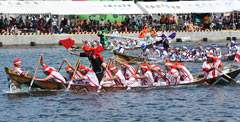
June 6, 2011 Ryukyu Shimpo
On May 4 of the old lunar calendar (June 5) or Yukka-nu-hi, Harley or Harri dragon-boat races were held in various locations in the prefecture to wish for safe navigation and a good season’s fishing. The Harley race held at the well-known fishing town of Itoman City, featured the largest number of teams to date in the organization section. Falling on a Sunday this year, Harley fans and family groups came to the Itoman Fishing Port in greater numbers than in recent years.
At the opening ceremony, all participants stood in moment’s silence for the victims of the Great East Japan Earthquake.
The Nijima Village team defeated its rivals from Nakamura and Nishimura in the traditional race section, winning the overall champion’s flag for the sixth consecutive year, winning the other two sections, the Ugan-Barley boat race and Agaisubu race (paddling a distance of 2.15 kilometers).
In his speech, Mayor of Itoman City Hirotsune Uehara stressed that, “We pray for an early recovery for the areas affected by the disasters. Next year a national event for ‘making the sea rich’ will be held in Itoman, and we will also do our very best to make it a success.”
(English Translation by T&CT, Mark Ealey)
Go To Video
Go To Japanese
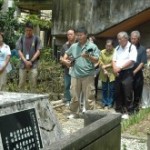
June 5, 2011 Ryukyu Shimpo
Fourteen Hawaiians originated from Okinawa, including 36 year-old Norman Kinjo visited the Miyamori Elementary School in Uruma City on June 3 to attend the memorial service held for the victims, including 11 children, killed in the June 30 1959 crash of a U.S. F-100 fighter from Kadena Air Base. At the memorial of Nakayoshi-Jizo or Good Friend-Jizo (protector of deceased children) on which the names of the victims are engraved, they offered prayers to comfort the spirits and sang an Okinawa folk song to the accompaniment of the sanshin. Mitsuteru Toyohama, the president of the Ishikawa-Miyamori 6-30 Association, guided them around the scene of the accident. He said, “Those who were killed would have been pleased with their visit.”
Kinjo, Erick Wada and their colleagues performed three songs, including Tinsagunu hana with vocals and sanshin accompaniment at the memorial service. Erick is a member of the Ukwanshin-Kabu-Dan in Hawaii. “Sightseeing is all very well, but we can’t gain a real understanding of our roots in Okinawa if we don’t also look at the deep sadness that sits in the background,” said Kinjo.
When the “Iha Four Sisters” Okinawan folk music group from Ishikawa in Uruma City toured Hawaii last December, Kinjo and others learned about the tragedy of the plane crashing into Miyamori Elementary School. Kumiko Iha, now 62 years old, but just a fifth grade girl back then, accompanied the young visitors from Hawaii on this trip. She was impressed that, “I told them just a little about it, but they were very interested in the incident. I actually learned something about Okinawa from them. They are wonderful, just like their fantastic music.”
(English Translation by T&CT, Mark Ealey)
Go To Japanese

June 5, 2011 Ryukyu Shimpo
Fifty-one year-old Dacy Tamayose, a second generation Okinawan-Canadian residing in Lethbridge City, Canada, has written a novel about the life of her mother, 76 year-old Naoko Tamayose, describing the legacy of the Okinawan spirit and how it seeks peace and beauty. Naoko Tamayose lived through the Battle of Okinawa before emigrating to Canada, where she devoted herself to the study of Ryukyuan dance. After learning Ryukyuan dance from her mother, and visiting Okinawa, Dacy Tamayose started to think about conveying the spirit of Okinawa and in 2007 published the novel “Odori.”
Dacy indicated that she would like to continue writing, saying, “I would really like to write a novel about some aspect of Okinawa.”
She is interested in how the Canadian-Okinawan community, which immigrants to Canada created, learned about Okinawan culture and inherited its spirit.
She was moved by the spirit and culture of Okinawa, then she visited her mother’s hometown of Hamahigajima (Uruma City), talked to relatives and went around the old battle sites in Itoman City. Her interest was further stimulated when she found the name of her aunt on the Shiraume Memorial.

“Odori,” a novel written by Dacy Tamayose.
Dacy said, “I have studied Ryukyuan dance. For me, the spirit and culture of Okinawa are important.”
In the novel entitled “Odori,” a third generation Canadian-Okinawan woman has a car accident in Canada in 1999. As she hovers between life and death, her great-grandmother appears in front of her eyes, telling her about the history of her family.
The novel depicts experiences in the Battle of Okinawa and the spirit of Ryukyuan dance.
Tears came to her mother Naoko’s eyes when she read the book. She said, “I experienced the war when I was nine-years old. My experiences fleeing from cave to cave were so frightening that I still cannot forget them. The scenes described in the novel stood out in my memory.”
Yoshitaka Kinjo, the head of Lethbridge Okinawa Cultural Society commented, “Dacy is keenly aware of her Uchinanchu heritage and she possesses great sensitivity. Her novel has been widely read, not only by the Canadians of Okinawan heritage, but also by many people in mainstream Canadian society, which is made up mainly of immigrants.”
(English Translation by T&CT, Mark Ealey)
June 4, 2011 Ryukyu Shimpo
On June 3, Head of the Executive Office of the Governor Susumu Matayoshi gave the media an explanation of his official trip to the United States, which commenced on May 22.
Matayoshi indicated a willingness to locate some form of center of information gathering in the United States to help push for the relocation of the Futenma Air Station out of the prefecture.
From May 24, Matayoshi traveled to Washington, D.C., New York and Boston, where he had talks with U.S. officials including Michael Schiffer, Deputy Assistant Secretary of Defense for Asian & Pacific Security Affairs, East Asia and other key figures. He explained to them Okinawa governor Hirokazu Nakaima’s policy regarding the request for the relocation of Futenma Air Station out of Okinawa. Matayoshi said, “Much more time is needed to get them to understand our views on the issue.”
He indicated the desire to locate some form of base of information gathering in the United States, saying, “Those whom I talked to don’t understand what the people of Okinawa want. They miss the point, asking things like ‘Does the Unites States need to give Okinawa money?’ Our task is to make sure that people in the United States at all levels of society know what the people of Okinawa truly want. The prefecture needs to establish direct channels of communication with the United States.”
With regard to Carl Levin, Chairman of the Senate Armed Services Committee, and John McCain, senior United States Senator, seeing the current plan put forward by both the U.S. and Japanese governments for the relocation of Futenma Air Station to Henoko, Nago City, as unrealistic, and suggesting the integration of Futenma Air Station into Kadena Air Base, Matayoshi said, “Although the U.S. government has said that it would deal with the situation based on the agreement between the Japanese and the U.S. governments, I did get the impression that the U.S. government is taking things seriously.”
Matayoshi also talked to the staff of Jim Webb, the senior United States Senator from Virginia who suggested the integration of Futenma Air Station into Kadena Air Base, saying, “They told me that the U.S. government and the Congress are not discussing the feasibility of that suggestion.”
Before returning to Okinawa on June 2, in the United States Matayoshi also met James Jones, a former United States National Security Advisor, Michael Green, a senior adviser of Center for Strategic and International Studies, and Ezra Vogel, the author of “Japan as Number One.”
(English Translation by T&CT, Mark Ealey)
Go To Japanese
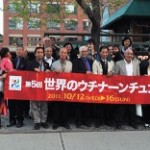
June 3, 2011 Tsuyoshi Arakaki of Ryukyu Shimpo
A roadshow across North America headed by the governor of Okinawa, Hirokazu Nakaima, who visited Canada to promote the 5th Worldwide Uchinanchu Festival scheduled for October, arrived in Calgary City, Canada in the afternoon on June 1.
That evening, the roadshow held its first explanatory meeting for the CALGARY OKINAWAN CLUB, which has about 50 members, in a restaurant in the city. Fourteen Canadians with Okinawan heritage attended the meeting.
Nakaima called for many people to attend the Festival, saying “I would like you to travel to Okinawa once every five years, and to tell us about the world.”
Seiichi Yamashiro, head of CALGARY OKINAWAN CLUB said, “Although 20 years have passed since we founded this organization, it is the first time for us to have the opportunity to welcome the Governor of Okinawa. We want to help make the Festival a success.”
(English Translation by T&CT, Mark Ealey)
Go TO Japanese

June 3, 2011 Ryukyu Shimpo
On June 2, the World Wildlife Fund (WWF) Japan announced that it has discovered a new species of numa-ebi, or Atyidae shrimp, during field research carried at Kumejima Island in February. The numa-ebi species normally inhabits the freshwater of lakes and rivers but the one species discovered at Kumejima was found living in seawater. This is an unprecedented case anywhere in the world.
The shrimp were collected by a team of marine biology researchers including Yoshihisa Fujita, a part-time lecturer at Ryukyu University and other institutions, who were during field work carried out as part of the WWF Japan “Kumejima Backup Project.”
The numa-ebi was found in an underwater cave about 35 meters deep. It is one centimeter in length and has degenerate eyes.
Among the Ryukyu Islands, Kumejima has a high level of biodiversity with some parts of the island being registered as a site in the Ramsar Convention. WWF Japan selected the island as a part of a priority biodiversity conservation area within the Ryukyu Islands.
Fujita said, “We expected that a new species would be found, because a new species of crab was found in the very same place about 10 years ago. With help from divers, we would like to continue this research.”
A conference presentation will be delivered on June 4 in the science complex building of Ryukyu University.
(English Translation by T&CT, Mark Ealey)
Go To Japanese
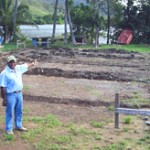
June 1, 2011 by Tsuyoshi Arakaki of the Ryukyu Shimpo
The Okinawan Japanese Community Association of New Caledonia, a special collectivity of France located in the South Pacific, and also known as the “island closest to Heaven,” has recently started construction of an “Okinawan House” designed to facilitate learning about the history of migration from Okinawa and the deepening of friendship with the people of Okinawa.
Almost 900 people emigrated to New Caledonia from Okinawa and it is estimated that 1500 people of Okinawan descent now reside there.
The president of the Association, Jean-Pierre Zenkoro, said that they have secured approximately 340 square meters of land, and will complete construction of the building this summer.
Located at a picturesque spot near the mouth of a river in Poindimie City, in the northern part of Grand Terre on the main island of New Caledonia, it will have a restaurant, meeting rooms, exhibition rooms and offices. The Northern State Government of New Caledonia is providing about 3,000,000 yen worth of financial assistance towards the cost of the construction.
The Association was established in Poindimie City and several other places in 2007. Many of its members will visit Okinawa to participate for the first time to attend the 5th Worldwide Uchinanchu Festival in October this year. Fifty people including the governor of the Northern State, who is also the mayor of Poindimie City will visit Okinawa from New Caledonia. Next July, the 120-year Anniversary Festival to commemorate Japanese immigration will also be held in New Caledonia.
The Okinawa-New Caledonia Friendship Association, headed by Takeshi Miki, will send about 30 people to that Festival next year. “Okinawan House is a symbol of friendship. We will use this opportunity to support it and to develop it as a venue for friendship much in the same way as the ‘Naha Shi Hotel,’ which was established and managed by an Okinawan,” he said. In next year’s festival commemorating Japanese immigration, an exhibition will be held at the “Okinawan House” and articles for display will be gifted from Okinawa.
(English Translation by T&CT, Mark Ealey)
Go To Japanese
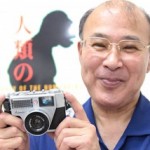
June 1, 2011 by Hutoshi Hanashiro of Ryukyu Shimpo
June 1 is “Photograph Day.” Before the return to Japanese sovereignty, cameras inscribed with the words “MADE IN RYUKYU” were produced in Okinawa. One such camera is the NEW PAX. Originally produced both for export and for sale to U.S. military personnel, at about US$12, production started in the Tomari area of Naha in 1963, but came to an end just two and a half years later in 1965 due to problems with the availability of the lens. Prized for its rarity, it is known as the “phantom camera.”
Its creator was the late Seiho Oyama, who passed away in 1996. Well known for discovering the Minatogawa man, the oldest example of modern Homo sapien in East Asia, he also founded the OK TRANSPORT Limited Partnership Company.
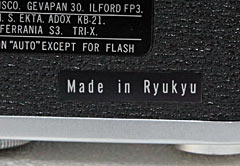
A NEW PAX, known as “the phantom camera.” Its back cover is inscribed with the words, “Made in Ryukyu.”
According to 59 year-old Seishin Oyama, second son of Seiho Oyama, his father emigrated to Canada, but then came back after the war to the devastation in Okinawa hoping to set up a business to help the Okinawan economy get back on its feet.
Seishin said, “Despite of its short time in production, the camera recorded two historically important events.” One is the excavation of the Minatogawa man, and the other is Warsaw Pact invasion of Czechoslovakia in 1968. When a friend of Oyama visited Czechoslovakia on holiday, he used his NEW PAX to take a picture of the invading Soviet tanks. The picture then appeared in newspapers in the main islands of Japan.
Ninety-three year-old Minoru Yamada, who owns a NEW PAX camera, said, “The camera was made during the Vietnam War. It has been witness to many of the historical events that have occurred between Okinawa and the United States. I really treasure mine.”
Sixty-nine year-old Takaaki Uehara, who also owns a NEW PAX, looked at his beloved camera, saying, “There are only few of them left. It is known as ‘the phantom camera.’ Those who know about it even come to take pictures of it.”
(English Translation by T&CT, Mark Ealey)
Go To Japanese
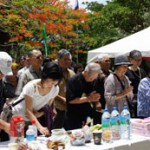
May 31, 2011 Ryukyu Shimpo
On the morning of May 30, members of “the Memorial and Friendship Tour from Okinawa to the Southern Islands” held the 42nd memorial service at the Okinawan memorial near Cape Mappi in Saipan, in the Northern Mariana Islands, for Okinawans killed in those regions during World War II. Organized by the South Sea Islands Returnees Association and the Okinawa Prefecture United Association for Bereaved Families, it was attended by some 130 people, including local participants, who offered prayers for members of their immediate families, and relatives, killed in battle 67 years ago.
Mayor of Saipan Donald G. Flores, accompanied by various other local officials and the Japanese Consul Tsutomu Higuchi also attended the service.
President of the Returnees Association Zenichi Taira said, “We are grateful to those of you whose souls rest here while we live in a peaceful world. It is our duty to pray for eternal peace and then to ensure that is achieved. We will continue to hold these memorial service tours into the future.”
As well as local offerings such as rice balls, the participants placed some brown sugar and sata-andagi cakes brought from Okinawa in front of the memorial. Tears flowed as those in attendance remembered their decreased relatives.
Another service will be held at the Okinawan memorial at Carolinas Plateau in Tinian On March 31.
(English Translation by T&CT, Mark Ealey)
Go To Japanese

May 28, 2011 Ryukyu Shimpo
Durl Gibbs is an 85 year-old U.S. veteran of World War II who now resides in Lewis Town, Montana. Sixty-six years ago during the Battle of Okinawa, Gibbs took the wallet from the body of a dead Japanese soldier, and decades later, he met 69 year-old Noriko Kikuchi, the daughter of the dead soldier to present the wallet to her.
Stumbling on his words, Gibbs said that he could not get the wallet out of his mind for those 66 years since the war. He went on to say, “Now, I finally feel at ease.” Kikuchi was grateful, saying, “I am sorry that this has weighed so heavily on you for such a long time.”
The wallet contained some photographs and an envelope inscribed with the Japanese soldier’s name – “Keijiro Hojo.” Inside was a lock of hair and some nail clippings.
Gibbs visited Okinawa in January 2011.
Shizuo Kishaba of the Ryukyu American Historical Research Society, a historical research group that facilitates the return of items to Okinawa and works to keep memories of the battle alive, helped Gibbs find Kikuchi, the daughter of Hojo.
Gibbs, who visited Kikuchi’s home with his two sons and a daughter, said, “When I got married and had a family, I started to think about the family of the Japanese soldier.” Speaking to her father’s relics, Kikuchi said, “You’ve finally come back home. I am relieved to have you back.”
Gibbs and his children also visited Hojo’s gravesite.
Seventy-seven year-old Shogo Kikuchi, husband of Noriko Kikuchi, and other relatives watched Gibbs as he made offerings of flowers and incense and put his hands together in prayer as he said, “Please rest in peace.”
Visiting the hometown of Hojo, with its peaceful paddy fields, Gibbs talked about his feelings after returning the relics that had been on his mind for such a long time, saying, “It was a peaceful and beautiful land. I never dreamed of such a day.”
Kikuchi, who had no knowledge of the relics of her father, who was killed in the Battle of Okinawa when she was 12, said, “I felt like I was meeting my father. He must have desperately wanted to go back home. I too felt like I was doing something that had to be done.”
(English Translation by T&CT, Mark Ealey)
Go To Japanese
May 28, 2011 Ryukyu Shimpo
On May 27, the Japanese government decided to issue multiple entry visas for Chinese tourists visiting Okinawa Prefecture from July 1. The visa can be used multiple times during the period of its validity. Minister in charge of Okinawa, Yukio Edano, announced this on May 27, and Foreign Minister Takeaki Matsumoto will officially inform the governor, Hirokazu Nakaima, on his first visit to Okinawa on May 28. It is thought that while the government stressed that the introduction of the new visa is in response to a request from the prefectural government and is aimed at Okinawan development, it will allow the foreign minister to curry some favor in a situation in which the gap between the local government and Tokyo on the Futenma issue is still as wide as ever. The visit will occur exactly one year after the most recent agreement between the governments of the United States and Japan on relocating the facilities and functions of the U.S. Marine Corps Air Station at Futenma to Henoko and returning the land to the residents.
Okinawa had actually asked the government for visa exemptions for Chinese to visit, mostly as a measure to stimulate tourism in the slowdown following the Great East Japan Earthquake, so this is not exactly what was requested of Tokyo. However, Governor Hirokazu Nakaime takes a favorable view, saying, “It will provide a shot in the arm for the Okinawan tourism industry.”
The visa is aimed at wealthy Chinese tourists. The visa holder is limited to Okinawa on his or her first visit but after that it is possible to move out of Okinawa to other locations in Japan. With these visas, they can visit other places including Tokyo without dropping in to Okinawa on their second or subsequent entry to Japan.
Edano said in his interview with the press, “The matter of the entry visa does involve national security. We decided on this to promote Okinawan economic development without creating issues for security, but we won’t stop here; we want to do more to help economic development in Okinawa.”
(English Translation by T&CT, Mark Ealey)
Go To Japanese











 Webcam(Kokusai Street)
Webcam(Kokusai Street)


